Sirens are often thought of as the dark and dangerous versions of mermaids. But are sirens mermaids? Or are they different creatures altogether? I did some research to find out how similar they really are.
Today, sirens and mermaids are mostly regarded as the same creatures because their respective myths intertwined during the last centuries.
Some languages like the romance languages Spanish and French etc., don’t even have separate terms for mermaids and sirens: They call both mermaids and sirens sirenas (Spanish) and sirènes (French).
But originally sirens and mermaids were very different creatures in mythology. They did not only look different but also behaved completely differently.
In this article, I’ll try to show you what the sirens were really like and how different they were from mermaids. For this, we mostly look at the sirens and sea nymphs (who most mermaids are based on) from Greek mythology. So, let’s start.
1. Sirens are dangerous but mermaids are friendly
The biggest difference between sirens and mermaids certainly is the fact that mermaids are generally friendly creatures while sirens are dangerous and even kill people.
In the most famous story in which sirens appeared, the Odyssey, the hero Odysseus gets warned about the sirens with the following words:
“First you will raise the island of the Sirens, those creatures who spellbind any man alive, whoever comes their way. Whoever draws too close, off guard, and catches the Sirens’ voices in the air — no sailing home for him, no wife rising to meet him, no happy children beaming up at their father’s face. The high, thrilling song of the Sirens will transfix him, lolling there in their meadow, round them heaps of corpses rotting away, rags of skin shriveling on their bones.“
Homer
That sounds pretty scary. Some writers later on even suggested that the sirens might have been cannibals, because of how the last sentence describes that the dead corpses lied around them.
However, it does not seem that the sirens actually ate their victims because the fact that it is described that the flesh was rotting, would suggest that it was simply decaying naturally.
An alternative interpretation would be that the humans that made it alive to the island that the sirens lived on simply starved to death because they were so hypnotized by the sirens that they did not eat anymore.
The way the sirens killed people was by luring them close to the rocky island they lived on so that the ships crashed into the rocks and sunk in front of their eyes.
The mermaids, on the other hand, are friendly, helpful and kind creatures. The sea nymphs (nereids) symbolized the beautiful and kind aspects of the sea and were represented as very beautiful girls.
They often wore branches of red coral as crowns and were dressed in white silk robes and sometimes rode on the back of dolphins or hippocampi through the sea. They furthermore often saved sailors and fishermen who were in danger on the sea, sometimes even saving them from drowning.
So, the mermaids are basically the opposite of the sirens if you consider that sirens kill sailors and mermaids save them.
2. Sirens were originally bird women
Even though Sirens are pretty much always shown as half woman half fish figures like mermaids nowadays, they originally looked very different. In ancient Greece, the sirens were thought of as half woman and half-bird creatures.
The oldest depictions in ancient Greek art show them having big bird bodies with only a woman’s head. They had bird feathers, which enabled them to fly and claw-like bird feet.
So, in the beginning, they were pretty much the opposite of mermaids. Birds and fish don’t have too much in common after all.
In the following picture, you can see one of the oldest depictions of sirens in ancient Greece. It is a stamnos drawing from around 480-470 B.C. (Stamnos was a type of ancient Greek pottery that held liquids, similar to a vase.)
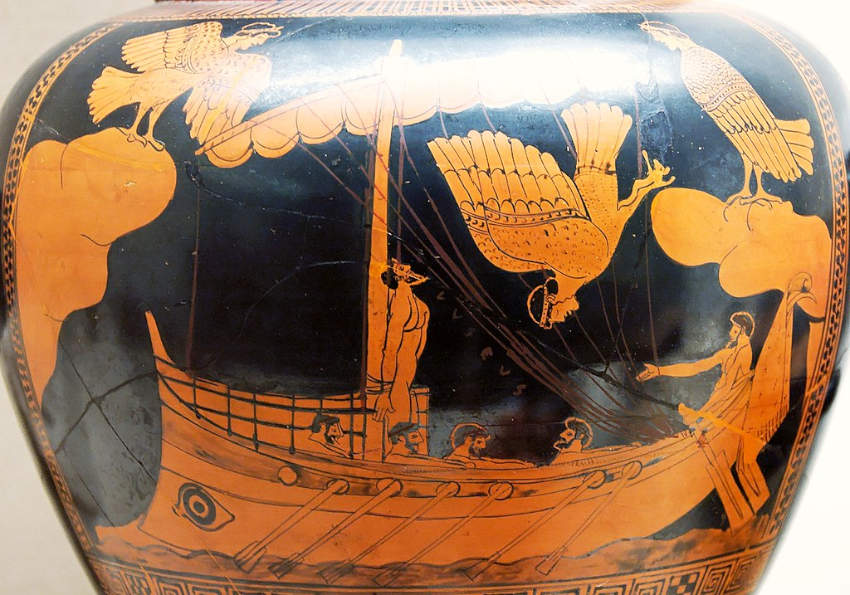
The drawing represents the most famous scene in the literature about the sirens ever: the scene in Homer’s epic poem called Odyssey (from around 675–725 B.C.) in which the main protagonist Odysseus and his crew sail past the island where the dangerous sirens live.
Because the sirens sing songs that make every person that hears them fall into a state of trance and desire to sail towards them, they usually blindly crash into the rocky coast of the sirens’ island and die.
But because Odysseus was warned about this danger, he made his crew clog their ears with wax, so they could not hear the sirens.
Odysseus himself, however, was curious and decided to tie himself to the mast of his ship so he could hear the sirens’ song without losing his mind and his life.
In the picture you can see Odysseus being tied to his mast while the sirens in bird form sing to him.
The depictions in art changed a bit throughout the centuries and thus the appearance of the sirens changed too. Instead of being a bird with a woman’s head, a bit later they were represented as a woman with only the legs and wings of a bird (see point 3 for a picture).
3. Sirens guided dead people to the otherworld
The sirens not only killed people though. They were also thought to accompany dead souls from the human world to the otherworld.
Thus, they belonged to the psychopomps of Greek mythology: creatures, spirits, etc. who escorted newly deceased souls from Earth to the afterlife. Consequently, they were also often referred to as the muses of the lower world.
Due to this association as psychopomps, the ancient Greeks placed siren statues on the graves of deceased family members. This was understood as a symbolic depiction of how their soul was guided to the otherworld. In the picture, you see such a statue.
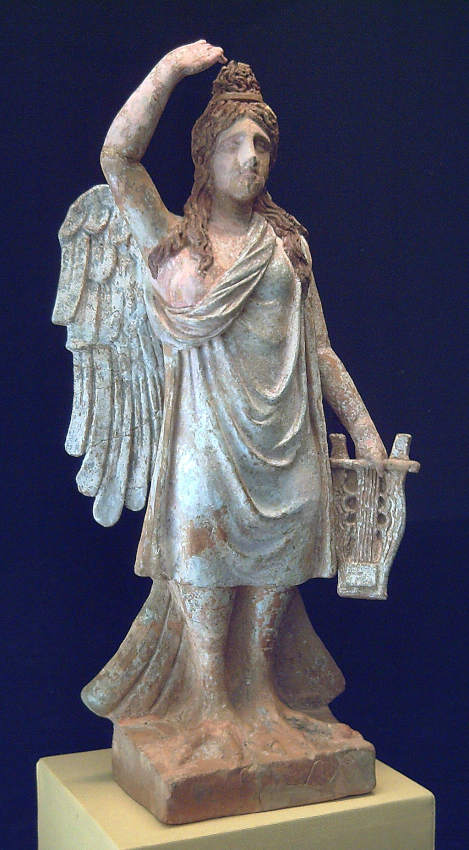
This statue is called the “Siren of Canosa” and was created around 320 and 300 B.C. She stems from Apulia, a place in southern Italy, which was heavily influenced by Greek immigrants in the classical era.
As you can see, she looked like a woman with bird features and was also carrying a zither (musical instrument). Her expression with the arm that is raised above the head was a typical sign of moaning and most likely expressed condolences towards the family.
The connection to the otherworld likely resulted from their bird-like appearance or the other way round. Birds were sometimes thought to be able to transcend the worlds. This idea of death-birds that had a connection to the realm of the souls was a rather common idea in some closeby cultures at that time [1].
In Syria figures of eagles on tombs also represented the guides of the souls and the ancient Egyptians even believed that the soul could leave a dead body in the form of a bird (often a hawk).
Mermaids were however never associated with the dead or the otherworld. As described in point 1, they rather represented the beauty and life of the sea.
4. Sirens only got their fishtails during the Middle Ages
After being depicted as bird or half-woman and half-bird creatures for centuries, in the medieval era, some painters started giving the sirens fishtails as many mermaids had.
It seems this change in appearance was partly influenced by the liberties the artists took in presenting the sirens.
But there was also a book that seems to have played a role in spreading this idea: the Book of Monsters (Liber Monstrorum) from around 700 A.D was the first piece of writing that described the sirens with a fishtail [1].
It is an Anglo-Latin catalog that listed and depicted many monsters that were known during medieval times. In the following excerpt, you can read how the sirens were defined in the book:
“Sirens are sea-girls, who deceive sailors with the outstanding beauty of their appearance and the sweetness of their song, and are most like human beings from the head to the navel, with the body of a maiden, but have scaly fishes’ tails, with which they always lurk in the sea.”
Book of Monsters
At first, bird and fish appearance were mixed up for a while though. The following picture is an example of a medieval depiction from around 1300 on which you can see three sirens with fishtails, bird feet and wings.
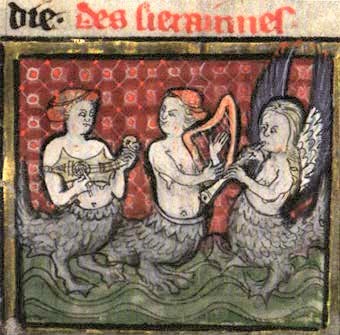
Not much later the sirens were mostly known for their fishtails.
The first depiction of a siren with a fishtail, as we know them today, stems from the Lutterell-Psalter from 1325/35. You can see the image here on the website of the British Library (scroll in, to the bottom of the page). She also holds a mirror and a comb in her hands as a sign of her worldly vanity [1].
This depiction also hints at the reason why the sirens possibly underwent this change in appearance from bird to fish: it might have had something to do with the rise of Christianity.
During the Middle Ages in Europe, the meaning of the sirens was reinterpreted in regard to Christian beliefs.
Medieval writers, like Konrad von Mengenberg (in his book of nature, 14th century), first described the sirens as “unvirtuous women who lull men into wickedness”, indirectly referring to the biblical myth of Adam and Eve, in which the woman Eve also behaved sinfully. Some medieval writers even went so far as to describe the sirens as “prostitutes” [1].
A possible interpretation for the bird to fish transformation is that the wings of the sirens were too similar to the wings of the angels and thus their appearance wasn’t in accordance with the ideas of Christianity and had to be changed [2].
Maybe the fact that the sirens’ parents were sea gods (see point 7) and the sirens killed sailors in the sea also influenced the decision to depict them with fish-tails instead of bird parts.
Altogether, it is not too surprising that their depictions changed. After all, in ancient texts like the Odyssey, the sirens’ appearance was not specified.
The mermaids never went through such a dramatic change in appearance though. The Tritons always had a fishtail. Just the nereids were mostly depicted in human form and only sometimes with tails.
But generally speaking, the fishtails were associated with the mermen (Tritons) and their female versions for a long time. There were even a few fresh-water nymphs and gods (e.g. Achilles) with fishtails.
5. Sirens were depicted with wings and two tails but mermaids were not
As mentioned the wings of the sirens were mostly a remnant of their bird-days (and their psychopomp character) and were used in depictions for some more time.
Even though the sirens were now depicted with a mermaid tail, they still had most characteristics that the sirens from the ancient Greek myths also had: most importantly their dangerous nature and power to lure sailors to their death with their voice.
Just the way they were interpreted had changed during the rule of Christianity.
This new way of interpreting the sirens as sinful women that seduce men is thought to be the reason why sirens were also depicted with two tails on many churches and buildings in Europe during the time of the late Middle Ages: as an off-putting representation of sinfulness [2].
In the following picture, you can see a drawing of a siren with both wings and two tails.
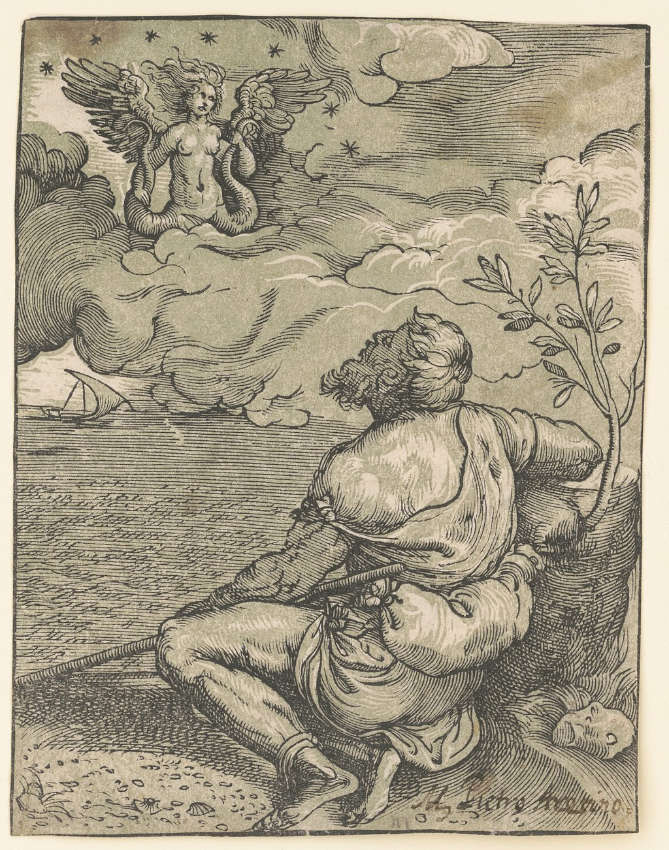
The two tails might have been used as a depiction of their promiscuity because having two parting tails allowed the sirens to sleep with men, while this was not possible with one tail [2].
Depictions with two tails were however also known from ancient Greek pictures of two-tailed Triton. So the reason for the two tails is not entirely clear.
If you are interested in the artwork of the sirens with two tails, you can check out this website that has a map with many pictures of these two-tailed sirens on different buildings in Europe.
As opposed to the sirens, mermaids were never depicted with wings and almost never with two tails. Only Triton sometimes had two tails.
6. The words “mermaid” and “siren” have totally different roots
Even the words siren and mermaid reflect the difference between these two beings.
The word siren comes from the ancient Greek word seirḗn (Σειρήν). The etymology of that word is not fully clear but it seems to be derived from the Semitic root for “singing” which is “sir” [1].
Others suggested that the word might be connected to the Greek word for “rope, cord” (σειρά = seirá), which would refer to how they bind people through their enchanting voice or even to how Odysseus had to be bound to the mast of his ship in order to survive them.
The word mermaid on the other hand is of Old English origin and means “a young girl from the sea” from mere (sea) and maid (girl or young woman).
And even the Greek words for the sea nymphs reflected this strong connection to the sea. The nereids are basically called “the wet/watery ones” because their name is derived from their father Nereus and his name is in turn derived from the old Greek word “neros” (νηρός) meaning “water”.
The root of the name of the Tritonides which comes from their father Triton (Τρίτων) isn’t exactly clear, but it seems to have a connection to a Celtic word which means “sea” (triath, declined trethan).
As you can see, the word siren is very strongly tied to their dangerous voice while the words for mermaid reflect their strong connection to the water and the sea.
7. In Greek mythology sirens and mermaids had different roots
When you look at the family tree of the Greek gods, nymphs and monsters, you can see that sirens and mermaids were actually very far away from each other.
In the following infographic that I made, you can see that the sirens were part of the era of the primordial gods on the top of the tree while the mermaids (sea nymphs and Tritonides) were part of the era of the Olympian gods on the very bottom of the family tree.
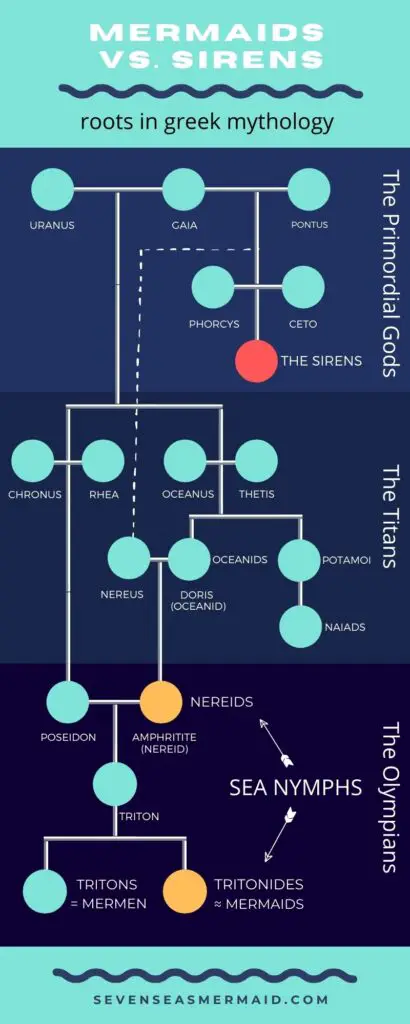
The sirens were the daughters of the sea god Phorcys and the sea goddess Ceto. The interesting thing is that their children were all sea-monsters!
Besides the sirens, their children included Scylla (sea-monster with several dog heads), the Gorgons (Medusa and her two sisters who had snakes as hair and could turn everyone into stone) and the Graeae (3 witches who only had one eye and tooth which they took turns using).
This suggests that the sirens should be classified as monsters as well. It should however be mentioned, that in some later texts a few specific sirens were described as the daughters of the river god (Potamoi) Achilles.
But I decided to stick to the older sources that classified them as the daughters of Phorcys and Ceto. For a great overview of the family tree of Greek mythology, check out this video by UsefulCharts on Youtube.
The mermaids, on the other hand, that is the sea nymphs like the nereids and Tritonides, are the daughters of sea gods and water or sea nymphs. So their friendly nature and beauty were literally in their genes thanks to their nymph mothers.
8. There were only a few sirens but many more mermaids
According to Homer, who wrote the Odyssey, there were actually only two sirens. Other Greek poets however claimed that there were between three and eight.
They were sometimes given names as well, but these varied from poet to poet. An example of names they were given are the names Peisinoe, Aglaope and Thelxiepeia.
The mermaids were far more in number in Greek mythology. There were exactly 50 nereids of which some also had children.
The number of the Tritonides wasn’t stated, but since mermaids, in contrast to the sirens, are known to reproduce, it is likely that they have multiplied over the years. This means that there would be thousands or more mermaids by now.
9. Sirens originally lived on a rocky island but mermaids lived in the ocean
As mentioned before, according to the ancient Greek myths, especially the story of Odysseus, the sirens lived on an island that was surrounded by cliffs and rocks.
Such rocky seashores are actually one of the most dangerous places for ships to pass because they can easily get caught in the wild currents and smash against the rocks which can make them sink.
The following illustration depicts these dangerous rocky shores well.
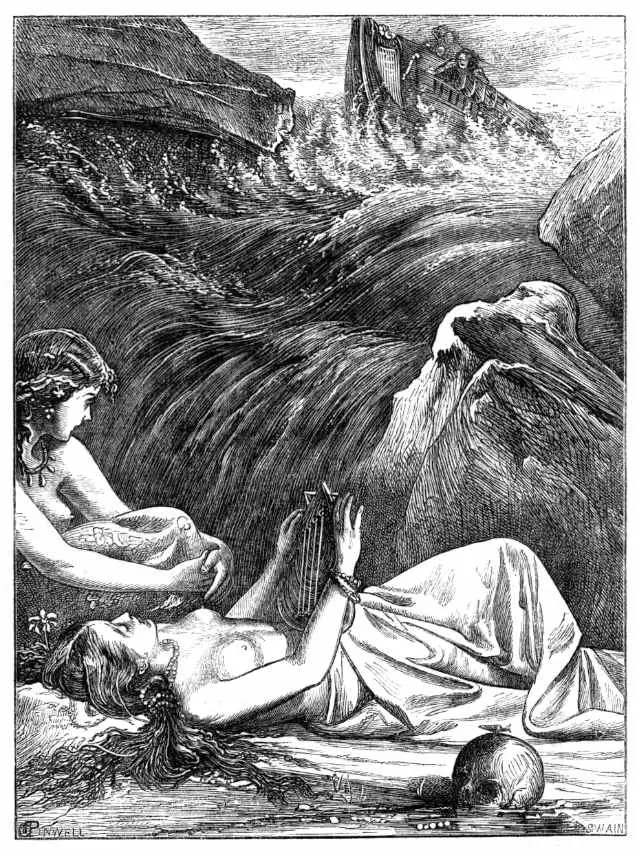
Because of how dangerous the waves can become in such places the sailors would often die, even if they made it out of the ship on time.
This connection to a dangerous path of water, that had to be passed, was an integral part of the stories about the sirens.
They were directly linked to the dangerous seashore, or maybe they actually were a representation of them, just like many creatures in Greek mythology represented and humanized a part of nature.
In this regard, the sirens seem to be similar to the two other sea monsters from the Odyssey: Charybdis and Scylla. You can read more about the marine hazard the sirens are connected to and the real islands they lived on in my post about whether sirens are real.
As mentioned in point 7, Scylla was actually a sister of the sirens. So, the connection between the dangerous rocky seashore in front of that island that the sirens lived on and the sirens’ way of luring in and killing sailors seems to have a similar root.
In the following picture, you can see where the sirens and mermaids lived.
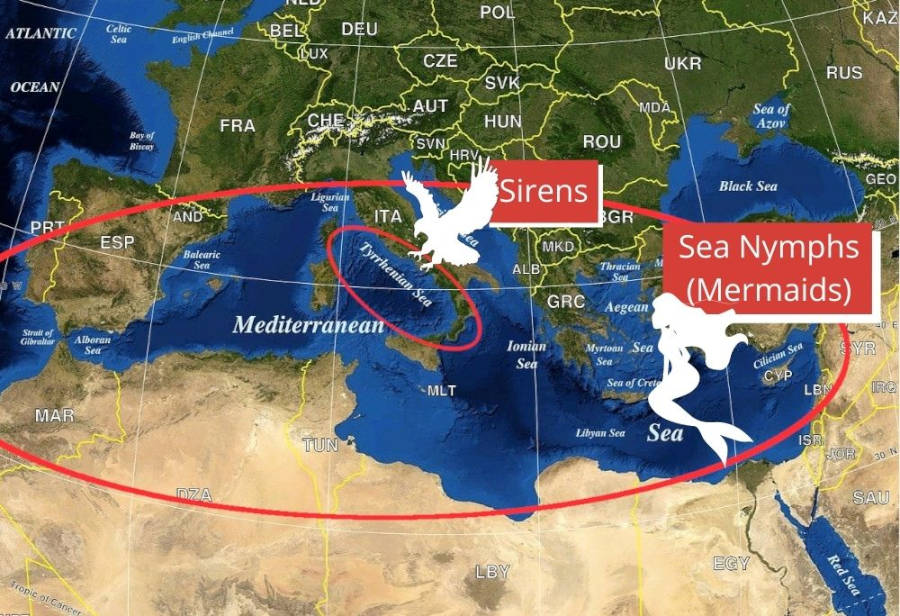
Mermaids, on the other hand, were always sea dwellers and not bound to a specific island or area.
The Nereids were said to live in the Aegean Sea between Greece and Turkey, where they stayed in a golden palace in the depths with their father Nereus (close to where the mermaid is in the picture).
But the other sea nymphs, the children of Triton, actually lived all over the Mediterranean Sea. And when the god Triton traveled the sea, both the Nereids and Tritons often followed him.
So you could say, that they were home in all of the Mediterranean Sea.
10. Sirens only appeared in Greek mythology but mermaids do in myths from around the world
The sirens are a totally Greek sea creature.
Even though there were a few similar bird creatures in other cultures and even in Greek mythology itself there were the harpies, they did not have the same story as the sirens, who lured sailors to their death. The harpies, for example, only stole food and nagged some people.
There are however two myths that bear a slight resemblance to how the sirens lured in sailors. Firstly, there is a Danish and Swedish medieval ballad in which elves try to seduce men with their beautiful singing.
Secondly, there is the story of the Loreley, a mermaid that lives at the most dangerous path of the Rhine river and lures sailors to their death by singing. But this story is actually based on a poem by the German author Clemens Brentano, which he wrote in 1801.
So both of these stories were possibly influenced by the sirens from Greek mythology (the Loreley definitely), whose story was written down by Homer as early as around 675–725 B.C. and thus you can say, that there isn’t really a similar myth out there.
Mermaids do however have counterparts around the world. The earliest myth about a mermaid actually comes from Syria. 3000 years ago Atargatis lost her husband and tried to drown herself out of sadness.
But the powers of the water transformed her into a mermaid and let her live on. She was worshiped as a fertility goddess in that area and all over the Mediterranean for a long time.
Other mermaids are the Mami Water from Africa, the Nixies from Germany and Scandinavia, the Yawkyawk from Australia and many more.
11. Sirens are only female but mermaids have male counterparts
In the ancient Greek texts, sirens were only ever described as female. Possibly because it is easier for females to lure in the male sailors with their voices.
In artistic portrayals, you could actually see male sirens as well, but only for a very short time until around the fifth century BC. Here (Getty Museum) you can see a vase drawing of a male siren with a beard in the form of a bird.
Once they were depicted as part woman and bird or fish they were always female in art too, just like in the myths. During the centuries, especially in Christian belief during the medieval era, they came to represent the dangerous female temptation that could mislead men.
So, it is safe to say, that sirens were exclusively female creatures.
Mermaids, on the other hand, had a lot of male counterparts in the past and today. The most famous merman is certainly Triton. He was mostly depicted with a fishtail, as you can see in the following stemnos (vase) drawing from around 560 to 550 B.C.
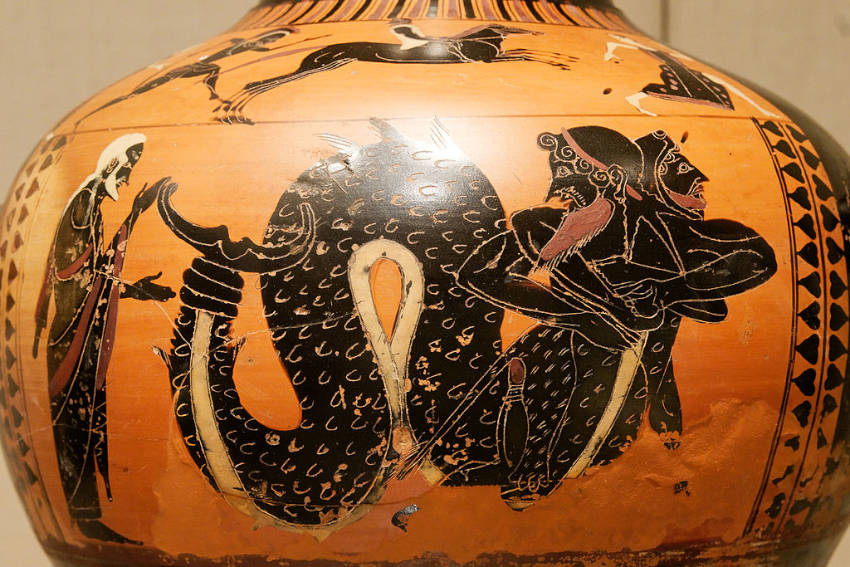
Triton was the kind of the sea and his children (or his plurification) were called the Tritons (males) and Tritonides (females). The Tritons were Poseidon’s companions (besides some Nereids) who always accompanied him on his travels through the sea.
Just like Triton they had fishtails. To signal that Poseidon was on his way, they were blowing their conch shells.
In the following picture, you can see a statue of one of the Tritons on the Trevi Fountain in Rome.
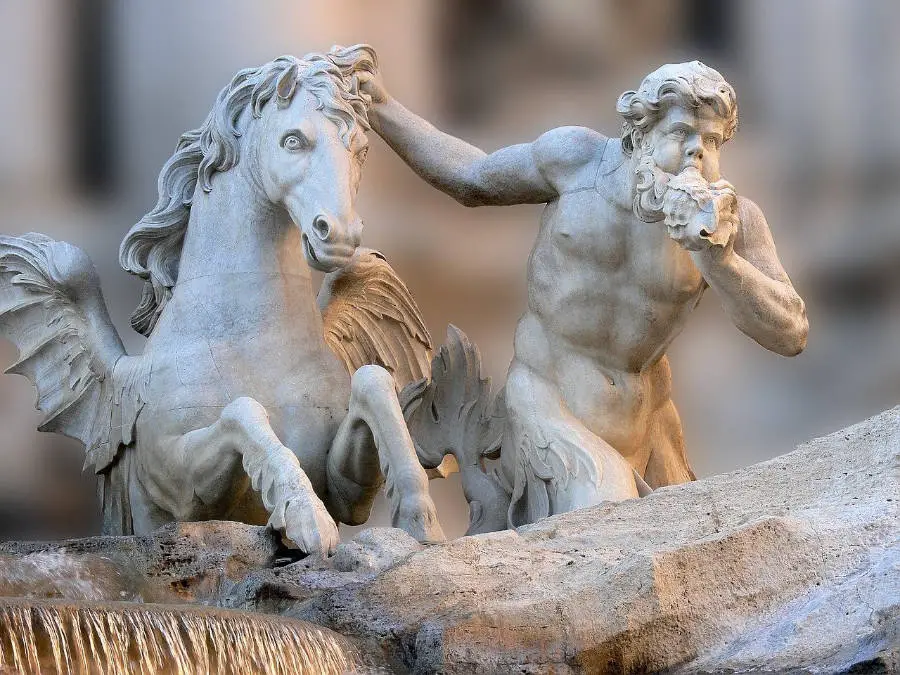
Furthermore, the nereids also had one brother called Nerites.
12. Sirens do not fall in love with men, only mermaids do
Even though sirens are often associated with the symbolic seduction of men, they actually never were interested in men in a romantic way [1,2].
In none of the original myths, they showed any interest in them, except when it came to killing them.
Mermaids, on the other hand, were generally interested in men. This is because nymphs in general often had a certain interest in humans.
For example, in the Odyssey, Odysseus was held captive by a nymph called Calypso (a sea nymph according to some writers) for seven years because she fell in love with him and wanted to make him her immortal husband.
Some of the sea nymphs even got married, like the two most well-known nereids, Amphitrite and Thetys. Amphitrite was the wife of the sea god Poseidon (and mother of Triton) and Thetis was even married to a mortal man, the hero Peleus. However, Thetis was forced into the marriage and was not in love with her husband.
The mermaids’ tendency to fall in love with men was most popularly written about in the literature of the romantic period with the story of the Little Mermaid by Hans Christian Andersen from 1837 and its Disney adaptation about Ariel being the most influential one.
13. Sirens did not have a connection to the sea like mermaids did
Mermaids or sea nymphs were part of the sea and lived all over the Mediterranean. Like other nymphs from Greek mythology, which are all nature spirits, they had a strong connection to nature and the element that they lived in.
For example, the fresh-water nymphs like the Oceanids and Naiads were the human forms of the rivers, streams, springs, etc. they each represented and cared for.
Similarly, other nymphs, like tree nymphs, represented their trees over which they watched.
The sea nymphs also took care of the sea in some ways. For example, in Book IV of Metamorphoses (740 ff), the author Ovid describes how the sea nymphs helped grow corals in the sea.
After the hero Perseus killed the monster Medusa, that had the power to turn everyone that looked at her to stone, he saw how Andromeda, the daughter of the king of Aethiopia, was threatened by a sea monster and hurried to her rescue.
The head of the dead Medusa was still in his sack and before he rescued the girl, he placed Medusa’s head on some seaweed on the edge of the water.
There something incredible happened. The blood of Medusa dripped onto the seaweed and turned it into what looked like red stone – coral!
The sea nymphs saw this and were so fascinated, that they quickly gathered more algae, soaked it in the blood and then planted the newly grown corals on the sea bed. So, according to this myth, the mermaids were responsible for spreading the corals in the Mediterranean Sea.
Other than that, they also were said to have certain powers that were connected to the sea.
Sirens did however not have such a connection to nature and the sea. This is probably due to the fact that they lived on their island and not in the sea itself and that they were busy luring sailors to their death.
14. Sirens could hypnotize humans with their voice, but mermaids didn’t
The sirens’ hypnotizing voices were one of the biggest differences to mermaids. The sirens were defined by the fact that they lured sailors to their death by singing their enchanting and irresistible songs to them.
The following painting depicts very vividly how entranced Odysseus looks bound to his mast when he encounters the singing sirens.
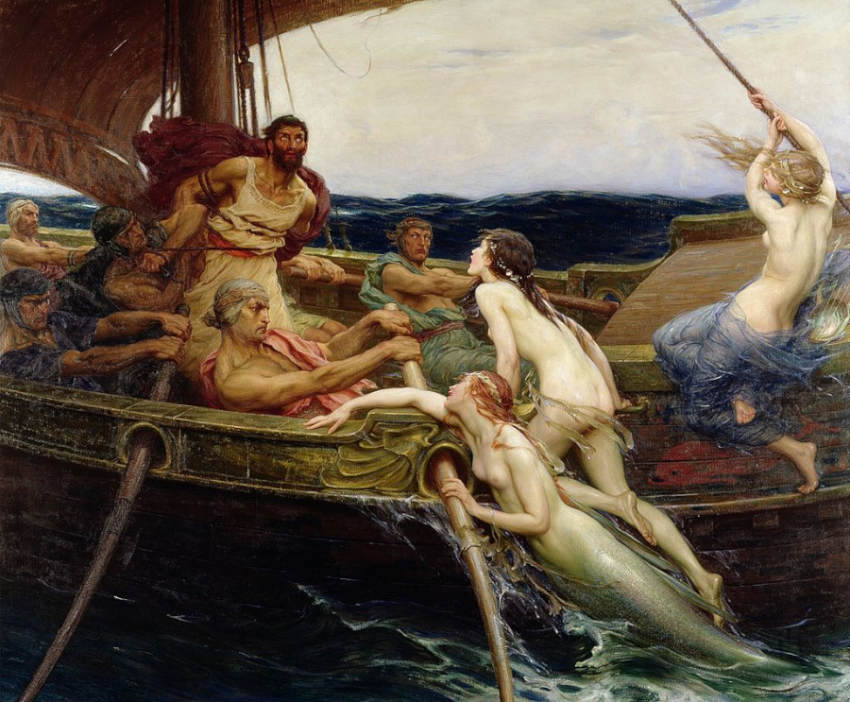
Their songs are also known as siren songs today and represent the enchanting and hypnotizing beauty of their singing.
Mermaids, on the other hand, were originally not as strongly associated with song and music, especially not with hypnotizing humans.
Today their beautiful voices are an integral part of their being as well, as you can see in movies like Ariel, the little Mermaid and others.
But this association, that mermaids are musical, actually came from the sirens when the two concepts of the mermaid and siren started to merge during the Middle Ages. The musicality was never a defining feature of the sea nymphs and mermaids before that.
15. Sirens were often depicted playing musical instruments but mermaids were not
As mentioned before, at first, the sirens were depicted as birds with women’s heads. Birds are always associated with beautiful songs.
But when artists started to draw them in more of a human form, whether as half-bird or half-fish, they needed something that showed their musicality at first glance and their new human arms were perfect to hold musical instruments.
On the following picture you can see three half-bird sirens playing flutes.

Besides flutes and other instruments, the sirens were most often portrayed with lyres (a form of a small harp that was common in Greece). You can see this in the pictures of points 3, 4 and 9.
The sea nymphs were however never depicted or described with a musical instrument. The only somewhat musical thing they did was when the Tritons blew their conch shells to signal that Poseidon was on his way over the sea.
16. Sirens were keepers of wisdom and forbidden knowledge
The songs that the sirens sang were not only a beautiful melody, but they actually made promises to tell give their victims secret knowledge or tell them something about themselves which made their songs even more enticing.
Some scholars even described them as mantic creatures that knew both the past and the future (Harrison).
You can understand why if you have a look at what they say to Odysseus in the Odyssey:
“Once he hears to his heart’s content, sails on, a wiser man.
Homer
We know all the pains that the Greeks and Trojans once endured
on the spreading plain of Troy when the gods willed it so—
all that comes to pass on the fertile earth, we know it all!”
They offer him to tell him something that will bring him enlightenment, make him a wiser man.
However this is a false promise, as they might not tell him this secret knowledge afterall and instead kill him.
Mermaids on the other hand, do not have such a gift of knowledge.
17. Sirens died in different ways than mermaids did
According to some post-Homeric authors, the sirens only had to die, if someone heard and still escaped their hypnotizing singing. This would mean that they would have died after Odysseus heard them.
But others say that they are pretty much immortal, especially since they were often described as the helpers of the god Hades from the otherworld.
Mermaids, as nymphs, were also very long-lived.
It is not very clear if they died, but since most nymphs die when the part of nature they represent dies (like a tree, river etc.) it seems likely that the sea nymphs only died if the sea they live in dried up or possibly were extremely polluted so that the life inside wasn’t possible anymore.
Literature:
[1] Kraß, Andreas (2010). Meerjungfrauen – Geschichten einer unmöglichen Liebe. FISCHER E-Books. (in German)
[2] Alexander, Skye (2012) Mermaids: The Myths, Legends, and Lore. Adams Media.
Main Image by John William Waterhouse, Public domain, via Wikimedia Commons

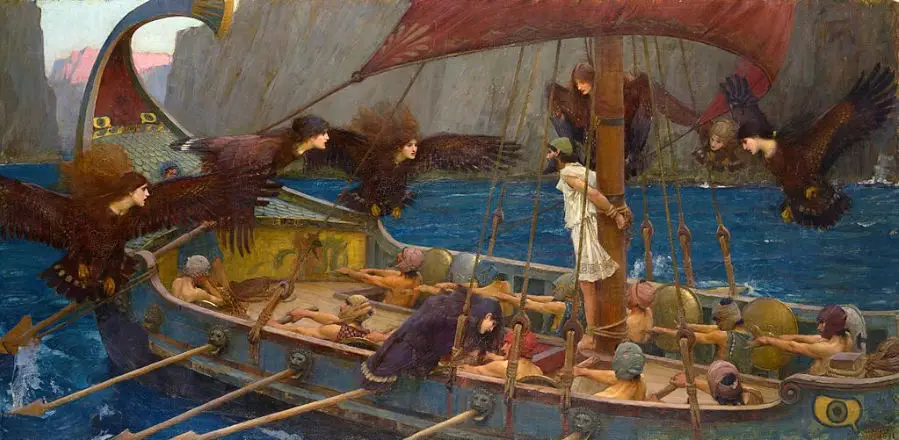

The most detailed analysis I have read about mermaids vs Sirens. Thank you
Thank you for sharing. I’m glad you found it interesting:)